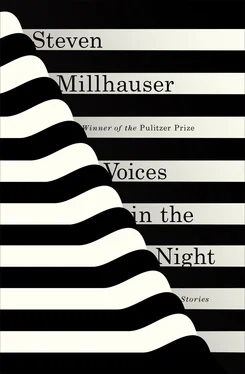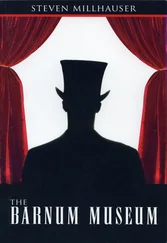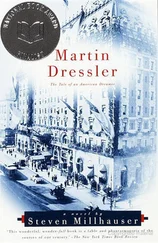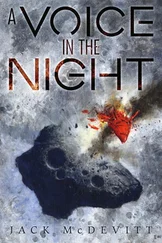“Are you all right?” I cried, but she was locked away in a dream. The side of her hand, where it had struck the chair, seemed hollowed out, as if a piece had chipped off. I looked desperately about. In her rigid condition I could not place her in a chair. For a wild moment I considered laying her across the piano bench.
I lifted my mother in my arms as if she were a young wife or a rolled-up rug and pushed open the door to the kitchen with my foot. The light had drained away. Gigantic leaves pushed up against the windows like hands. With my foot I dragged two chairs from the kitchen table and arranged them side by side. I laid my mother across the seats so that she was pushed up safely against the backs, then rushed over to the old phone on the counter. The line was dead. Dusty cobwebs stretched across the dial.
I understood that it was imperative to remain calm, that a solution would present itself, but I found it difficult to concentrate my attention. My mother’s position on the chairs seemed perilous. When I bent over to make certain she was safe, I saw that her dress was twisted and the top buttons had come undone. A knob of collarbone thrust up like a knuckle.
Carefully, tenderly, I lifted her in my arms. Her face was smooth and calm. In her hardened state, she seemed to be content. I looked about the kitchen, which was sinking out of sight. I had the sense of a forest springing up outside.
Holding my mother tightly in my curled arms, I returned to the blackness of the living room. I could see nothing. Her bed lay far away. I thought of the couch, which stood hidden across immense stretches of dark. Even if I could find my way there, even if I could lay her gently down, I imagined her rolling slowly off the cushions and cracking against the edge of the coffee table. Maybe I wasn’t thinking clearly, maybe I wasn’t thinking at all, but as I gazed frantically around the dark I found myself calling to mind the corner near the piano, where the tall vase had once stood. She had always loved that vase.
Still holding my mother sideways in my arms, as if I were carrying her across a stream, I made my way along the rug to the space between the piano and the rocking chair. They rose up darker than the dark. “Are you all right?” I whispered. My mother said nothing. I tipped my arms to one side until I felt her foot touch the rug. Carefully I stood her upright. Gently I leaned her at an angle against the side of the piano. “There,” I said. I drew up the rocking chair so that it rested against the edge of her tilted foot, then stepped away.
In the stillness of the living room my mother stood leaning against the piano, as though she were listening intently to someone playing the slow movement of a sonata. She seemed at peace, there in her favorite room, lounging against the old piano, as she used to do. It was she who had taught me to play the piano, when I was seven, and she often liked to stay quiet like that, listening to me play. She was safer here, it seemed to me, than anywhere else, I said to myself, at least for the time being, I thought. For a while I stood in the dark, watching my mother at rest in her corner. Then I came forward and kissed her stony shoulder. “It was good seeing you again,” I said. I would make the necessary calls, I would see to it that she was looked after properly. I stepped back and gave a little wave.
When I reached the front hall I turned to look at the living room, which was no longer there. My visit had had its ups and downs, not everything had gone as smoothly as I might have liked, but we had talked a little, my mother and I, we had sat in the old places. Now she was resting at a safe angle against the side of the piano. She would be all right, I felt, in her way. I cast a farewell glance in her direction, giving a final wave into the dark, and as I turned toward whatever was left of the day or night I took what consolation I could in knowing that we’d had a good visit, taken all in all, and that I was bound to be out that way, once again, in a while.
The mermaid washed up on our public beach in the early morning of June 19, at approximately 4:30 a.m., according to the most reliable estimates. At 5:06 a.m. the body was discovered by George Caldwell, a forty-year-old postal worker who lived two blocks from the water and was fond of his early-morning swim. Caldwell found her lying just below the tide line; he thought she was a teenager who had drowned. The body lay on its side among strings of seaweed and scattered mussel shells. Caldwell stepped back. He did not want trouble. He immediately called 911 on his cell and stood waiting in the near-dark some ten feet from the drowned girl until two police cars and an ambulance pulled up in the beach parking lot. The sun had not yet come up but a band of sky over the water was turning pearly gray. “I thought she was a high school girl,” Caldwell later told a reporter; we read it in the Listener . “It was still dark out there. I thought she was wearing some sort of a dress with the top torn off. I could tell she didn’t look right. I didn’t want to get too close.” The body was taken to the Vanderhorn Funeral Home on Broadbridge Avenue and examined by the coroner and three local doctors. The initial report stated that the body “had the appearance of a mermaid” but that further tests would have to be conducted before a definitive statement could be issued. Two marine biologists from a nearby university arrived a few hours later and confirmed the accuracy of the initial examination, stating in their confidential report that there could be no doubt the mermaid was authentic.
From the beginning our town was torn between the impulse to disclose everything and the desire to protect our streets from media invasion. Officials cooperated as fully as possible with outside investigators but refused to allow photographs of our mermaid. They also refused to relinquish ownership of the body, which was claimed as town property. A special committee, appointed to handle mermaid affairs, voted to permit the release of the body for twenty-four hours into the care of a hospital in Hartford, where further tests were performed and tissue samples collected.
The mermaid was said to be sixteen years old and in excellent health. The cause of death was blood loss from a large wound in the lower fishbody, which appeared to have been attacked by a shark. We learned that she had human lungs, a human heart, a human stomach, and part of a human intestinal tract; below the waist, where the skin grew seamlessly into scales, the inner organs, including the reproductive system, were those of a large saltwater fish. She had green eyes, a small straight nose, small ears lying flat against the head, and well-formed teeth. Her hair was abundant and lustrous, a mixture of straw and blond, and fell in long undulations to her waist. The scales were gray-green, with brown and black markings. They were spread across the back of the fishbody and came around to the front, leaving on the belly a strip of whiteness about ten inches wide that tapered to four inches at the tail. The forked tail fin grew parallel to the human shoulders; such an arrangement suggested that the mermaid swam on her stomach, with the fin held horizontally, in the manner of a dolphin or whale, although one scientist stated emphatically that they were only making the best possible guess, since nothing at all was known about the habits of mermaids and she might sometimes have swum on her side, with the fin in a vertical position.
An immediate question arose: What should be done with our mermaid? The body was being held at the funeral home, where experts were invited to find ways of preventing decomposition. The Committee, in an emergency session, voted unanimously that a discovery of this kind was too important to be kept away from the residents of our town, who deserved to see the natural wonder for themselves. The issue was urgent; already there was talk of a disturbing odor. A team of biologists from a research lab in New Haven proposed a method of arterial injection with a newly developed non-formaldehyde solution that preserved organs and prevented shrinkage; in this way the mermaid might be kept on display for several weeks or more. A debate ensued about a suitable location for such an exhibit. Some suggested the town hall, others the library, but quite apart from questions of space it wasn’t difficult to find persuasive arguments against the display of a half-naked sixteen-year-old girl in public institutions intended for business or study. It was finally decided to house the display at the Historical Society, which had a small room for temporary exhibits. Objections were raised by those who felt that the body of a mermaid washed up on a beach had no place in a building dedicated to the history of our town, but they were outnumbered by those who argued that the Historical Society was the closest thing we had to a museum.
Читать дальше












